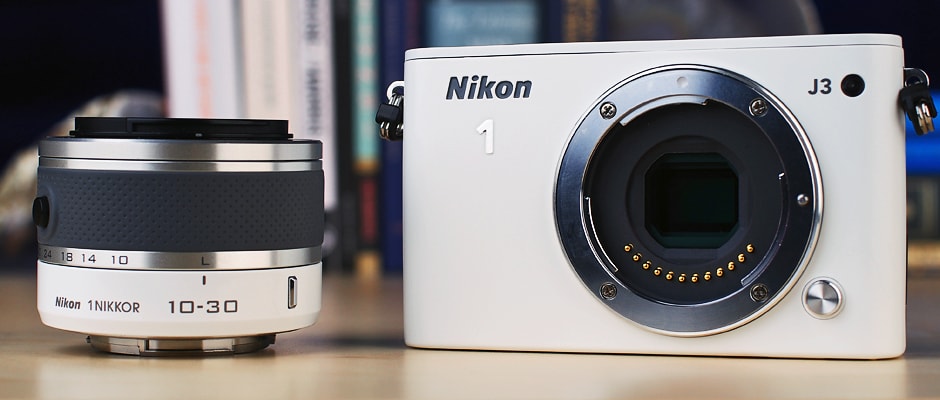Pros
Cons
Introduction
The J sub-series has been a hit with consumers who want a compact, no-frills interchangeable lens camera with a smart design. But at a $499.95 kit price, the new Nikon 1 S1 provides practically the same thing for $100 less. Is Nikon's own S1 the J3's biggest competitor?
Hands-on Video
Design & Usability
{{section_header}}{{section.name}}{{/section_header}}
The J3 is still svelte in size, but the lack of a grip is troublesome.
Just like previous Nikon J-series models. the J3 has a smooth plastic exterior without much grip to speak of. Its small, pocketable body has just a few manual controls and a single rear control dial. The J3's design is practically identical to the J1 and J2's, though Nikon has moved the mode dial to the top plate of the camera, freeing up room for your thumb on the back. It's still not the easiest camera to hold, though its stylish looks give it a wide appeal and won't scare off those stepping up from compact cameras.
While Nikon has positioned the new V2 to appeal to more advanced photographers, the J- and S-series cameras are designed for those who don't necessarily need advanced controls right at their fingertips. That isn't to say that the J3 is lacking in overall control or ability, however. The J3 features a full suite of aperture-priority, shutter-priority, program auto, and manual shooting modes. The camera is also capable of a maximum shutter speed of 1/16000th of a second, 400 and 1200fps high-speed video recording, and 1080/60i video with simultaneous image capture.
On the inside, the J3 features an upgraded 14-megapixel CX-format CMOS image sensor with hybrid autofocus. The camera also has the new EXPEED 3A image processor, which should be slightly faster than the processor found on first-generation Nikon 1 cameras. While we haven't seen much of an improvement here at CES, we're keen to get the camera back into our labs for a full comparison.
{{photo_gallery "FI Front Photo", "FI Back Photo", "FI Left Photo", "FI Right Photo", "FI Top Photo", "FI Bottom Photo", "FI Lens Photo", "FI Lens Mount Photo", "FI Viewfinder Photo", "FI LCD Photo", "FI Flash Photo", "FI Battery Photo", "FI Media Photo", "FI Ports Photo 1", "FI Ports Photo 2", "FI Handling Photo 1", "FI Handling Photo 2", "FI Ease OF Use Photo", "FI Auto Mode Photo", "FI Manual Controls Photo"}}
Features
{{section_header}}{{section.name}}{{/section_header}}
Nikon puts its new processor to good use in the J3.
Like all Nikon 1-series cameras, the Nikon 1 J3 features some rather incredible speed-centric features. The J3 offers 15 frames per second continuous shooting with autofocus, thanks to its hybrid contrast/phase detection autofocus. With focus locked at the first shot, the J3 can even record up to 60 full-resolution frames in a single second. That processing power also shows up when recording video, which now tops out at 1080/60i with the ability to capture full-resolution still images simultaneously.
Nikon's put that speed to good use, with the J3 now sharing the innovative "Slow View" function. With this activated, holding the shutter button down halfway will cause the camera to capture the scene in front of you, playing it back at 5x slow motion. This loops continuously, letting you press the shutter button the rest of the way down to take the frame you want. When you can just capture 60 full res frames per second normally it's not the most crucial feature, but it's a fun way to get the shot you want without having to sift through dozens of shots later.
While we're continuously impressed by the speed features of the Nikon 1 series, the J3 has to cope with a new obstacle to its success: Nikon's own S1 model. In terms of hardware design the S1 has a lower resolution LCD (461k-dot compared to the J3's 921k-dot display) and lacks a physical mode dial, but otherwise is practically identical. On the inside the two cameras share the same image processor, though the S1 uses an older 10-megapixel CX format sensor.

Conclusion
{{section_header}}{{section.name}}{{/section_header}}
The J3's new sensor and low price add up to another compelling entry-level option for Nikon shooters.
Almost by default, the J3 has been positioned as the mid-range model in Nikon's mirrorless camera line. While the J3 does feature some small upgrades over the J1 and J2, the debut of the Nikon 1 S1—with a $499.95 kit price and a very similar feature set—is certainly going to give entry-level buyers pause.
At a $599.95 kit price the J3 is certainly not overpriced, but on paper it doesn't provide many compelling reasons to pass over the S1. The big question mark, of course, will be the new 14-megapixel CX CMOS image sensor. The S1 uses an older 10-megapixel sensor, so the J3 may provide improved image quality. If the improvement is marginal, then it will be a tough sell to convince users that it's worth an extra $100 for a mode dial and a higher resolution screen.
That's a question we're going to have to address at a later date, once we have production samples in our labs for full testing. In the meantime you can consider us intrigued about Nikon's latest mirrorless cameras. The combination of speed and size has always been compelling, but at new, lower price points the entry-level Nikon 1 cameras provide a great deal of value for your dollar.
Specs
{{manufacturer_specs_table}}
Meet the tester
TJ is the former Director of Content Development at Reviewed. He is a Massachusetts native and has covered electronics, cameras, TVs, smartphones, parenting, and more for Reviewed. He is from the self-styled "Cranberry Capitol of the World," which is, in fact, a real thing.
Checking our work.
Our team is here to help you buy the best stuff and love what you own. Our writers, editors, and experts obsess over the products we cover to make sure you're confident and satisfied. Have a different opinion about something we recommend? Email us and we'll compare notes.
Shoot us an email

